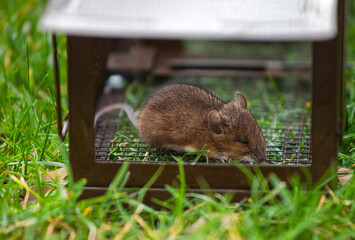Table of Contents
Do you have mice running around your house, leaving droppings and making a mess? Are you looking for a way to get rid of them without resorting to harmful chemicals or traps that could harm your family or pets?
Then, you need to learn how to make an effective, eco-friendly DIY mouse trap box. This simple and cost-effective trap will help you get rid of mice quickly and humanely without the need for harsh and expensive solutions. This guide will walk you through the steps of building and using a DIY mouse trap box, so you can finally get rid of those pesky critters and keep them away for good.
Got mouse problems? RECON Pest Services is here to help. Serving the greater Omaha and Lincoln areas, we have the tools and skills needed to remove any common pest from your home or business. Contact us today for a free quote.
Materials Needed
There are many materials you can use to make a DIY mouse trap box. Some of the most common materials used for these traps include:
– Cardboard is a great, cost-effective and eco-friendly material to make a mouse trap out of. This material is sturdy enough to hold the weight of the box and the mouse, but light enough that the mice can’t chew through it.
– Wood is another popular option, thanks to its strength, durability, and eco-friendliness.
– Metal is another good choice, as it is durable, lightweight, and rust-proof.
– Plastic is another strong and sturdy material to use, as well as being lightweight and cheap.
– You will also need a stick, some thin wire, and a cloth to hide the trap in.
Don’t forget bait! Peanut butter works best, in our experience, but some store-bought baits work even better.
Step-By-Step Guide to Building the Trap
Cage/box traps are an effective and humane way to catch mice. These traps are designed to trap the mice inside a small cage, where they cannot escape and they cannot be harmed by people or animals.
Here’s how to build a cage/box trap…
1. Cut a piece of cardboard, wood, metal or plastic into a square or rectangular shape that is large enough to fit the mouse.
2. Make two holes in the sides of the box for the entrance and exit points for the mouse. The entrance hole should be about 1-2 inches in diameter and the exit hole should be about 4-5 inches in diameter.
3. Place bait inside the box to lure in the mice. Peanut butter, cheese, or other food items work well as bait.
4. Place a stick or pole inside the box with one end resting on top of the bait and one end resting on top of an empty can or jar lid that has been turned upside down on its side at one end of the box.
5. Place a piece of string, fishing line or wire through both holes and tie it around the stick so that when it is pulled, it will knock over the can or jar lid, trapping the mouse inside.
6. Cover the box with a piece of cloth or other material to make it dark inside, and place it in an area where you have seen mice.
7. Check the mouse trap box regularly, and if a mouse is caught, dispose of it humanely.
Tips for Increasing Trap Efficiency
There are many things you can do to increase the efficiency of your DIY mouse trap. Here are just a few things to keep in mind while building and using your trap.
– Place the trap in a high-traffic area. You’ll want to place the trap where you’ve seen signs of mice the most, so the mice can easily find the trap and get caught.
– Use a strong bait, like peanut butter. Mice love peanut butter, so using it as bait will increase your chances of catching a mouse quickly.
How to Dispose of Mice Caught in the Trap
After you’ve caught a mouse with your trap, the first thing you’ll need to do is decide what to do with them. It’s important to remember that mice are rodents, not insects, so it’s best to release them outside. If you’ve used a cage trap, you can simply open the cage, remove the mouse, and set it outside without touching it. Once you’ve done that, you can close the cage and set the trap again.
Of course, be sure to release the mouse far away from your home so it doesn’t come back. Additionally, don’t release it on someone else’s property, as this is often illegal depending on the municipality.
Alternatives to the Mouse Trap Box
If you’ve tried everything and nothing seems to be working, there are a few alternatives to DIY mouse traps that might work better for you.
– Rodenticides are harmful chemicals designed to kill rodents, including mice, rats, and squirrels. These products are dangerous to people and animals, so they should be used with caution. However, if you have a serious infestation, these are worth considering.
– Snap traps are another popular option, but they are a lethal option. Keep in mind you’ll have to deal with a dead mouse if it’s effective!
– Glue traps can also work, but are typically less effective than snap or box traps because it’s easier for the rat to escape. Also, they aren’t particularly humane.
– Professional Exterminators are the most effective way to get rid of mice. Professionals will use their years of experience to determine the best way to rid your home of mice, so you can get back to enjoying your home.
Conclusion
Mice can be a nuisance, but they don’t have to be. With a DIY mouse trap, you can quickly and easily rid your home of mice without resorting to harsh chemicals or dangerous traps. All you have to do is choose the best trap for your situation, build it using the materials recommended above, and follow the steps for setting and activating the trap. Once you’ve done that, all you have to do is wait for the mice to come and get caught in your trap. Happy hunting!





